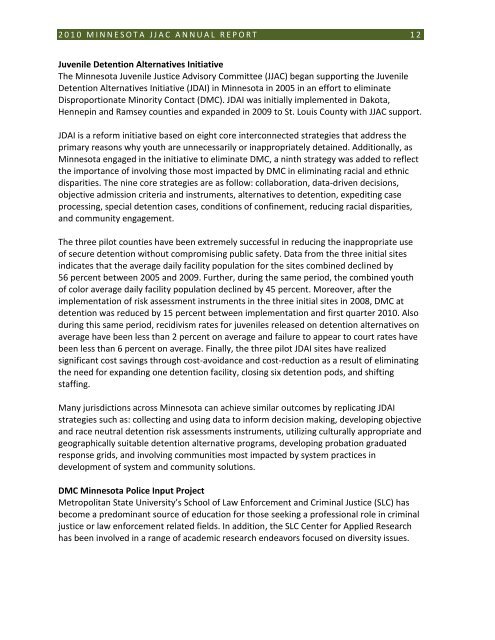Minnesota Juvenile Justice Advisory Committee - Minnesota State ...
Minnesota Juvenile Justice Advisory Committee - Minnesota State ...
Minnesota Juvenile Justice Advisory Committee - Minnesota State ...
You also want an ePaper? Increase the reach of your titles
YUMPU automatically turns print PDFs into web optimized ePapers that Google loves.
2 0 1 0 M I N N E S O T A J J A C A N N U A L R E P O R T 12<br />
<strong>Juvenile</strong> Detention Alternatives Initiative<br />
The <strong>Minnesota</strong> <strong>Juvenile</strong> <strong>Justice</strong> <strong>Advisory</strong> <strong>Committee</strong> (JJAC) began supporting the <strong>Juvenile</strong><br />
Detention Alternatives Initiative (JDAI) in <strong>Minnesota</strong> in 2005 in an effort to eliminate<br />
Disproportionate Minority Contact (DMC). JDAI was initially implemented in Dakota,<br />
Hennepin and Ramsey counties and expanded in 2009 to St. Louis County with JJAC support.<br />
JDAI is a reform initiative based on eight core interconnected strategies that address the<br />
primary reasons why youth are unnecessarily or inappropriately detained. Additionally, as<br />
<strong>Minnesota</strong> engaged in the initiative to eliminate DMC, a ninth strategy was added to reflect<br />
the importance of involving those most impacted by DMC in eliminating racial and ethnic<br />
disparities. The nine core strategies are as follow: collaboration, data-driven decisions,<br />
objective admission criteria and instruments, alternatives to detention, expediting case<br />
processing, special detention cases, conditions of confinement, reducing racial disparities,<br />
and community engagement.<br />
The three pilot counties have been extremely successful in reducing the inappropriate use<br />
of secure detention without compromising public safety. Data from the three initial sites<br />
indicates that the average daily facility population for the sites combined declined by<br />
56 percent between 2005 and 2009. Further, during the same period, the combined youth<br />
of color average daily facility population declined by 45 percent. Moreover, after the<br />
implementation of risk assessment instruments in the three initial sites in 2008, DMC at<br />
detention was reduced by 15 percent between implementation and first quarter 2010. Also<br />
during this same period, recidivism rates for juveniles released on detention alternatives on<br />
average have been less than 2 percent on average and failure to appear to court rates have<br />
been less than 6 percent on average. Finally, the three pilot JDAI sites have realized<br />
significant cost savings through cost-avoidance and cost-reduction as a result of eliminating<br />
the need for expanding one detention facility, closing six detention pods, and shifting<br />
staffing.<br />
Many jurisdictions across <strong>Minnesota</strong> can achieve similar outcomes by replicating JDAI<br />
strategies such as: collecting and using data to inform decision making, developing objective<br />
and race neutral detention risk assessments instruments, utilizing culturally appropriate and<br />
geographically suitable detention alternative programs, developing probation graduated<br />
response grids, and involving communities most impacted by system practices in<br />
development of system and community solutions.<br />
DMC <strong>Minnesota</strong> Police Input Project<br />
Metropolitan <strong>State</strong> University’s School of Law Enforcement and Criminal <strong>Justice</strong> (SLC) has<br />
become a predominant source of education for those seeking a professional role in criminal<br />
justice or law enforcement related fields. In addition, the SLC Center for Applied Research<br />
has been involved in a range of academic research endeavors focused on diversity issues.

















